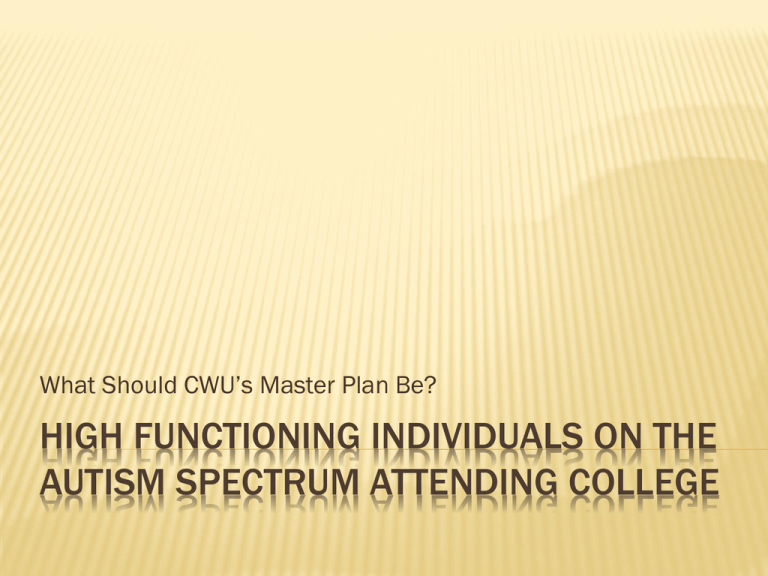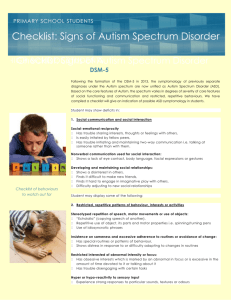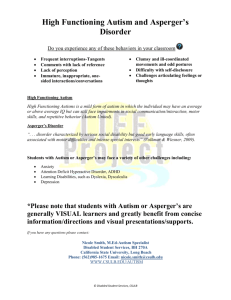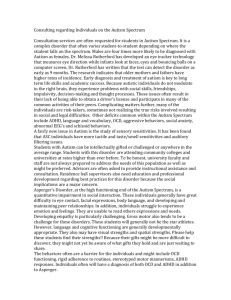Autism Spectrum Disorder - Central Washington University
advertisement

What Should CWU’s Master Plan Be? HIGH FUNCTIONING INDIVIDUALS ON THE AUTISM SPECTRUM ATTENDING COLLEGE BACKGROUND First, many higher-functioning adults on the autism spectrum are never formally diagnosed and thereby often do not qualify for services during their K-12 years. Second, incidence of autism is increasing, making the number of adults that are somewhere on the spectrum and in need of support higher than ever before. Third, higher-functioning adults on the autism spectrum are enrolling in college and other post-secondary training institutions at higher rates than ever before. Fourth, although data aren’t available, there are some who believe these students drop out at higher-thantypical rates because they aren’t adequately supported. Transitions to Adulthood AUTISM SPECTRUM DISORDER: DIAGNOSIS Both tables are from the Centers for Disease Control and Prevention Website INCIDENCE OF ASPERGER’S SYNDROME Studies vary in their estimates of the incidence of Asperger’s syndrome among children in the United States from 2 out of every 10,000 children to 30–40 of every 10,000 children have this condition. Asperger's syndrome affects boys more often than girls, and siblings of children with the disorder are at increased risk. DEFINITION AND CLASSIFICATION—DSM V Currently, autistic disorder and Asperger’s syndrome are separately defined and classified. However, in the upcoming revision to the Diagnostic and Statistical Manual of Mental Disorders (DSM), the diagnostic encyclopedia of American psychiatry, that’s about to change. Following are the criteria, which are anticipated to be voted on in June, that are proposed for the combined diagnosis, autism spectrum disorder. DSM V – PROPOSED LANGUAGE A. Persistent deficits in social communication and social interaction across contexts, not accounted for by general developmental delays, and manifested by all three of the following: 1. Deficits in social-emotional reciprocity; ranging from abnormal social approach and failure of normal back-and-forth conversation, through reduced sharing of interests, emotions, and affect and response, to total lack of initiation of social interaction, DSM V – PROPOSED LANGUAGE A. Persistent deficits in social communication and social interaction across contexts, not accounted for by general developmental delays, and manifested by all three of the following: 2. Deficits in nonverbal communicative behaviors used for social interaction; ranging from poorly integrated verbal and nonverbal communication, through abnormalities in eye contact and body language or deficits in understanding and use of nonverbal communication, to total lack of facial expression or gestures. DSM V – PROPOSED LANGUAGE A. Persistent deficits in social communication and social interaction across contexts, not accounted for by general developmental delays, and manifested by all three of the following: 3. Deficits in developing and maintaining relationships appropriate to developmental level (beyond those with caregivers); ranging from difficulties adjusting behavior to suit different social contexts, through difficulties in sharing imaginative play and in making friends, to an apparent absence of interest in people. DSM V – PROPOSED LANGUAGE B. Restricted, repetitive patterns of behavior, interests, or activities as manifested by at least two of the following: 1. Stereotyped or repetitive speech, motor movements, or use of objects (such as simple motor stereotypies, echolalia, repetitive use of objects, or idiosyncratic phrases); DSM V – PROPOSED LANGUAGE B. Restricted, repetitive patterns of behavior, interests, or activities as manifested by at least two of the following: 2. Excessive adherence to routines, ritualized patterns of verbal or nonverbal behavior, or excessive resistance to change (such as motoric rituals, insistence on same route or food, repetitive questioning or extreme distress at small changes); DSM V – PROPOSED LANGUAGE B. Restricted, repetitive patterns of behavior, interests, or activities as manifested by at least two of the following: 3. Highly restricted, fixated interests that are abnormal in intensity or focus (such as strong attachment to or preoccupation with unusual objects, excessively circumscribed or perseverative interests); DSM V – PROPOSED LANGUAGE B. Restricted, repetitive patterns of behavior, interests, or activities as manifested by at least two of the following: 4. Hyper-or hypo-reactivity to sensory input or unusual interest in sensory aspects of environment (such as apparent indifference to pain/heat/cold, adverse response to specific sounds or textures, excessive smelling or touching of objects, fascination with lights or spinning objects). DSM V – PROPOSED LANGUAGE C. Symptoms must be present in early childhood (but may not become fully manifest until social demands exceed limited capacities). D. Symptoms together limit and impair everyday functioning. Two numerical scales of severity are planned to locate each individual on the continuum. HOW IS THIS DIFFERENT THAN DSM –IV? DSM – IV: Pervasive Developmental Disorders (also known as Autism Spectrum Disorders) The current DSM lists five diagnoses within the PDD (ASD) category. 299.00 Autistic Disorder 299.80 Pervasive Developmental Disorder, Not Otherwise Specified 299.80 Asperger's Disorder 299.80 Rett's Disorder 299.10 Childhood Disintegrative Disorder WHY THE CHANGE? The intent: To make things cleaner and easier for those who will be using the criteria. (Dr. Gil Tippy, Clinical Director of The Rebecca School, Manhattan, New York) To ensure that autism “is not used as a fallback diagnosis for children whose primary trait might be, for instance, an intellectual disability or aggression.” (Task force member Catherine Lord) WHAT CATEGORIES ARE ELIMINATED? Asperger’s Syndrome (AS) Pervasive Developmental Disorder - Not Otherwise Specified (PDD-NOS) Non-Verbal Learning Disability (NLD) CONCERNS ABOUT NEW LANGUAGE The current edition of the DSM — DSM IV — gives Asperger’s, along with several other subgroups of autism, its own labels. It’s widely agreed that these subgroups have been poorly defined, thus generating a fair amount of confusion and subjectivity around diagnosis. Concerns have been voiced primarily from the Asperger’s community, who believe that the new language will reduce the number of “higher functioning” autistic individuals—those on the “right side” of the spectrum—who are diagnosed and have access to appropriate treatment. CONCERNS ABOUT NEW LANGUAGE This is, at least in part, due to the later onset of symptoms that are easily identified and to the current tendency for this diagnosis to be made considerably later in life than is the Autistic Disorder or Pervasive Developmental Disorder, Not Otherwise Specified. In other words, many adults are now being diagnosed with Asperger’s Syndrome. In the past, however, very few adults were diagnosed with autism disorder. DIAGNOSTIC CRITERIA FOR 299.80 ASPERGER’S DISORDER – DSM IV (I) Qualitative impairment in social interaction, as manifested by at least two of the following: (A) marked impairments in the use of multiple nonverbal behaviors such as eye-to-eye gaze, facial expression, body posture, and gestures to regulate social interaction (B) failure to develop peer relationships appropriate to developmental level (C) a lack of spontaneous seeking to share enjoyment, interest or achievements with other people, (e.g., by a lack of showing, bringing, or pointing out objects of interest to other people) (D) lack of social or emotional reciprocity. DIAGNOSTIC CRITERIA FOR 299.80 ASPERGER’S DISORDER – DSM IV (II) Restricted repetitive & stereotyped patterns of behavior, interests and activities, as manifested by at least one of the following: (A) encompassing preoccupation with one or more stereotyped and restricted patterns of interest that is abnormal either in intensity or focus (B) apparently inflexible adherence to specific, nonfunctional routines or rituals (C) stereotyped and repetitive motor mannerisms (e.g., hand or finger flapping or twisting, or complex whole-body movements) (D) persistent preoccupation with parts of objects. DIAGNOSTIC CRITERIA FOR 299.80 ASPERGER’S DISORDER – DSM IV (III) The disturbance causes clinically significant impairments in social, occupational, or other important areas of functioning. (IV) There is no clinically significant general delay in language (e.g., single words used by age 2 years, communicative phrases used by age 3 years) (V) There is no clinically significant delay in cognitive development or in the development of age-appropriate self help skills, adaptive behavior (other than in social interaction) and curiosity about the environment in childhood. (VI) Criteria are not met for another specific Pervasive Developmental Disorder or Schizophrenia. THE GOOD NEWS The American Psychiatric Association and clinicians are already watching to see how or if the new criteria will affect service availability. Their greatest fear is that insurance companies may use the revision to find ways to deny services to higher functioning individuals on the autism spectrum and so they have vowed to ensure this doesn’t happen. It remains to be seen. Transitions to Adulthood AUTISM SPECTRUM DISORDER WHAT HAPPENS WHEN CHILDREN WITH AUTISM BECOME ADULTS WITH AUTISM? “National, state and local policy makers have been working hard to meet the needs of the growing numbers of young children identified as having an ASD,” says Paul Shattuck, PhD, assistant professor at the Brown School at Washington University in St. Louis. “However, there has been no effort of a corresponding magnitude to plan for ensuring continuity of supports and services as these children age into adulthood.” WHAT HAPPENS WHEN CHILDREN WITH AUTISM BECOME ADULTS WITH AUTISM? Shattuck’s article in the current edition of the Archives of Pediatric and Adolescent Medicine describes the findings of a first-of-its-kind study of service use among young adults with an ASD during their first few years after leaving high school. He found that 39.1 percent of these young adults received no speech therapy, mental health, medical diagnostics or case management services. the odds of not receiving any services were more than three times higher for African-American young adults compared with white young adults and more than five times higher for those with incomes of $25,000 or less relative to those with incomes over $75,000. Overall rates of service use declined significantly from high school to postsecondary status. Specifically 46.9% compared to 23.5% for medical services; 46.2% compared to 35 % for mental health services; 63.6% compared to 41.9% for case management; 74.6% compared to 9.1% for speech therapy. WHAT HAPPENS WHEN CHILDREN WITH AUTISM BECOME ADULTS WITH AUTISM? Shattuck notes that the years immediately following the age at which students typically exit from high school are pivotal for all young adults but especially for those on the autism spectrum. Many of the higher functioning young adults on the autism spectrum—typically those currently bearing the Asperger’s diagnosis or even some never formally diagnosed—are coming to college. Only recently have colleges and universities begun to consider the ramifications of this growing number of students on the autism spectrum. WHAT ARE OTHER COLLEGES DOING? The model college program at Marshall University in Huntington, WV is a support program organized by the West Virginia Autism Training Center that provides directed guidance on academics, daily living, and social interaction to autistic college students (Tracjtenberg, 2008). Other colleges and universities that have launched autismspecific support programs in the last seven years include: Western Kentucky University; Fairleigh Dickson University in New Jersey; University of Arizona; University of Alabama; Oakland University in Michigan; Keene State College in New Hampshire. WHAT ARE OTHER COLLEGES DOING? Kim Ramsey, the Marshall program's director, indicated that the students are intellectually capable of meeting the university’s academic standards but that social and daily living issues are interfering. In response to that, the program offers tutoring, counseling, a quiet space to take exams, and help in the navigation of the bureaucracy and social world of college, i.e. how to schedule classes, join clubs, buy books, and replace ATM cards that don't work. ACADEMIC ASSISTANCE AND ACCOMMODATION First and foremost, students who believe they are on the spectrum should ask for an evaluation so they may be formally diagnosed and eligible for services. Second, the institution’s disability support operations and other student services should develop familiarity with the diagnosis and the particular support that is needed to achieve academic success. This may include, but not be limited to: Class selection and scheduling Social networking Support related to executive function—understand requirements for and completing paperwork in a timely way, tracking assignments and appointments. CLASS SELECTION AND SCHEDULING Although students on the spectrum are expected to meet the school’s academic requirements, some faculty and some class structures may work better for them than others. Similarly, some students on the spectrum may work better in a situation in which they have time for decompression between classes. Others may do better in classes that allow for tests to be taken with the aid of a computer. Last, some students may need support to complete certain class activities including, but not limited to: Group activities Choosing a seat that will provide the least distraction Public speaking. SOCIAL NETWORKING This is a particularly vulnerable area for many students on the autism spectrum. Their deficits in this area may result in loneliness and, eventually, they may drop out of school if their needs aren’t met. Schools can provide Counseling services. Social groups that take advantage of like characteristics or interests. Educational programs aimed at improving initiation and maintenance of relationships. EXECUTIVE FUNCTION Students on the autism spectrum often have difficulty in tracking appointments and assignments. To assist them, schools might offer Education in the use of smart phones for scheduling and for reminders. This work has proven very effective for those with traumatic brain injury and holds great promise for those on the autism spectrum. Support for developing and maintaining a workable schedule that accommodates required assignments, for example daily or weekly check-ins. FOR MORE INFORMATION ON TRANSITION . . . Go to the Family Services Transition Tool Kit at the Autism Speaks web site. YOUR TURN…. What other services might CWU provide to students on the autism spectrum?







